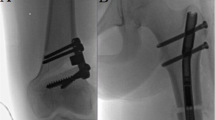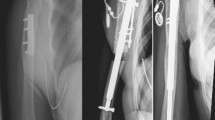Abstract
Background
Control of distraction rate with an intramedullary skeletal kinetic distractor (ISKD) may be problematic and a high distraction rate may result in insufficient bone regenerate.
Questions/purposes
Are distraction problems preventable when using the ISKD, and what are the risk factors for and radiologic types of insufficient bone regenerate during ISKD lengthening?
Patients and Methods
We analyzed 37 consecutive ISKD femoral lengthening procedures in 35 patients with a mean age 33 ± 11 years and minimum followup of 12 months (average, 27 ± 9 months; range, 12–55 months). The average length gain was 42.8 ± 12.9 mm.
Results
Eight patients had problems during distraction: seven had “runaway nails” and one had a nondistracting nail. Insufficient bone regenerate developed in eight patients. Important risk factors were a distraction rate greater than 1.5 mm/day (9.1 times higher risk), age 30 years or older, smoking, and lengthening greater than 4 cm. Less important risk factors identified were creation of the osteotomy at the site of previous trauma or surgery and acute correction of associated deformities. We proposed a radiologic classification for failure of bone regeneration: partial regenerate failure (Type I) or complete failure resulting in a segmental defect subdivided according to a length of 3 cm or less (Type IIa) or greater than 3 cm (Type IIb).
Conclusions
Distraction problems with the ISKD were related mostly to internal malfunction of the lengthening mechanism. A distraction rate greater than 1.5 mm/day should be avoided in femoral intramedullary lengthening. Smoking should be a contraindication for femoral lengthening.
Level of Evidence
Level II, prognostic study. See Guidelines for Authors for a complete description of levels of evidence.




Similar content being viewed by others
References
Aronson J. Basic science and biological principles of distraction osteogenesis. In: Robert Rozbruch S, Ilizarov S, eds. Limb Lengthening and Reconstruction Surgery. New York, NY: Informa Healthcare; 2007:19–42.
Baumgart R, Betz A, Schweiberer L. A fully implantable motorized intramedullary nail for limb lengthening and bone transport. Clin Orthop Relat Res. 1997;343:135–143.
Brutscher R, Rahn BA, Ruter A, Perren SM. The role of corticotomy and osteotomy in the treatment of bone defects using the Ilizarov technique. J Orthop Trauma. 1993;7:261–269.
Cole JD, Justin D, Kasparis T, DeVlught D, Knobloch C. The intramedullary skeletal kinetic distractor (ISKD): first clinical results of a new intramedullary nail for lengthening of the femur and tibia. Injury 32(4):129–139.
DeCoster TA, Gehlert RJ, Mikola EA, Pirela-Cruz MA. Management of posttraumatic segmental bone defects. J Am Acad Orthop Surg. 2004;12:28–38.
Fink B, Krieger M, Strauss JM, Opheys C, Menkhaus S, Fischer J, Ruther W. Osteoneogenesis and its influencing factors during treatment with the Ilizarov method. Clin Orthop Relat Res. 1996;323:261–272.
Fischgrund J, Paley D, Suter C. Variables affecting time to bone healing during limb lengthening. Clin Orthop Relat Res. 1994;301:31–37.
Garcia-Cimbrelo E, Curto de la Mano A, Garcia-Rey E, Cordero J, Marti-Ciruelos R. The intramedullary elongation nail for femoral lengthening. J Bone Joint Surg Br. 2002;84:971–977.
Gravel CA, Le TT, Chapman MW. Effect of neoadjuvant chemotherapy on distraction osteogenesis in the goat model. Clin Orthop Relat Res. 2003;412:213–224.
Guichet JM, Braillon P, Bodenreider O, Lascombes P. Periosteum and bone marrow in bone lengthening: a DEXA quantitative evaluation in rabbits. Acta Orthop Scand. 1998;69:527–531.
Guichet JM, Casar RS. Mechanical characterization of a totally intramedullary gradual elongation nail. Clin Orthop Relat Res. 1997;337:281–290.
Guichet JM, Deromedis B, Donnan LT, Peretti G, Lascombes P, Bado F. Gradual femoral lengthening with the Albizzia intramedullary nail. J Bone Joint Surg Am. 2003;85:838–848.
Hankemeier S, Gosling T, Pape HC, Wiebking U, Krettek C. Limb lengthening with the Intramedullary Skeletal Kinetic Distractor (ISKD). Oper Orthop Traumatol. 2005;17:79–101.
Hankemeier S, Liodakis E, Kenawey M, Krettek C. What is new in the management of bone defects? In: Meßmer K, Jähne J, Neuhaus P, eds. What Is New in Surgery? [in German]. Landsberg, Germany: Verlagsgruppe Hüthig Jehle Rehm GmbH; 2009:291–300.
Hankemeier S, Pape HC, Gosling T, Hufner T, Richter M, Krettek C. Improved comfort in lower limb lengthening with the intramedullary skeletal kinetic distractor: principles and preliminary clinical experiences. Arch Orthop Trauma Surg. 2004;124:129–133.
Ilizarov GA. The tension-stress effect on the genesis and growth of tissues: Part I. The influence of stability of fixation and soft-tissue preservation. Clin Orthop Relat Res. 1989;238:249–281.
Ilizarov GA. The tension-stress effect on the genesis and growth of tissues: Part II. The influence of the rate and frequency of distraction. Clin Orthop Relat Res. 1989;239:263–285.
Kojimoto H, Yasui N, Goto T, Matsuda S, Shimomura Y. Bone lengthening in rabbits by callus distraction: the role of periosteum and endosteum. J Bone Joint Surg Br. 1988;70:543–549.
Kubiak EN, Strauss E, Grant A, Feldman D, Egol KA. Early complications encountered using a self-lengthening intramedullary nail for the correction of limb length inequality. Joint Dis Rel Surg. 2007;18:52–57.
Leidinger B, Winkelmann W, Roedl R. [Limb lengthening with a fully implantable mechanical distraction intramedullary nail] [in German]. Z Orthop Ihre Grenzgeb. 2006;144:419–426.
Li R, Saleh M, Yang L, Coulton L. Radiographic classification of osteogenesis during bone distraction. J Orthop Res. 2006;24:339–347.
Paley D. Problems, obstacles, and complications of limb lengthening by the Ilizarov technique. Clin Orthop Relat Res. 1990;250:81–104.
Paley D, Herzenberg JE, Paremain G, Bhave A. Femoral lengthening over an intramedullary nail: a matched-case comparison with Ilizarov femoral lengthening. J Bone Joint Surg Am. 1997;79:1464–1480.
Schiller JR, Moore DC, Ehrlich MG. Increased lengthening rate decreases expression of fibroblast growth factor 2, platelet-derived growth factor, vascular endothelial growth factor, and CD31 in a rat model of distraction osteogenesis. J Pediatr Orthop. 2007;27:961–968.
Simpson AH, Cole AS, Kenwright J. Leg lengthening over an intramedullary nail. J Bone Joint Surg Br. 1999;81:1041–1045.
Simpson AH, Shalaby H, Keenan G. Femoral lengthening with the Intramedullary Skeletal Kinetic Distractor. J Bone Joint Surg Br. 2009;91:955–961.
Singh S, Lahiri A, Iqbal M. The results of limb lengthening by callus distraction using an extending intramedullary nail (Fitbone) in non-traumatic disorders. J Bone Joint Surg Br. 2006;88:938–942.
Tselentakis G, Kitano M, Owen PJ, Kuiper JH, Richardson JB, Evans GA. The behaviour of the periosteum during callotasis. J Pediatr Orthop B. 2003;12:277–283.
Watson JT, Kuldjanov D. Bone defects. In: Rozbruch SR, Ilizarov S, eds. Limb Lengthening and Reconstruction Surgery. New York, NY: Informa Healthcare; 2007:185–201.
Yasui N, Kojimoto H, Sasaki K, Kitada A, Shimizu H, Shimomura Y. Factors affecting callus distraction in limb lengthening. Clin Orthop Relat Res. 1993;293:55–60.
Yasui N, Kojimoto H, Shimizu H, Shimomura Y. The effect of distraction upon bone, muscle, and periosteum. Orthop Clin North Am. 1991;22:563–567.
Zheng LW, Ma L, Cheung LK. Changes in blood perfusion and bone healing induced by nicotine during distraction osteogenesis. Bone. 2008;43:355–361.
Author information
Authors and Affiliations
Corresponding author
Additional information
Each author certifies that he or she has no commercial associations (eg, consultancies, stock ownership, equity interest, patent/licensing arrangements, etc) that might pose a conflict of interest in connection with the submitted article.
Each author certifies that his or her institution approved the human protocol for this investigation, that all investigations were conducted in conformity with ethical principles of research, and that informed consent for participation in the study was obtained.
This work was performed at the Trauma Department, Hannover Medical School, Hannover, Germany.
About this article
Cite this article
Kenawey, M., Krettek, C., Liodakis, E. et al. Insufficient Bone Regenerate after Intramedullary Femoral Lengthening: Risk Factors and Classification System. Clin Orthop Relat Res 469, 264–273 (2011). https://doi.org/10.1007/s11999-010-1332-6
Received:
Accepted:
Published:
Issue Date:
DOI: https://doi.org/10.1007/s11999-010-1332-6




